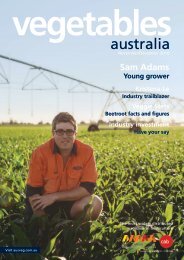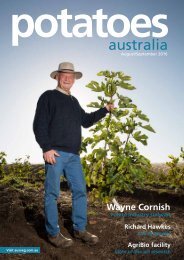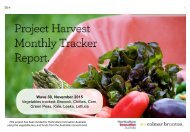potatoes
PA-DECJAN2016
PA-DECJAN2016
Create successful ePaper yourself
Turn your PDF publications into a flip-book with our unique Google optimized e-Paper software.
14<br />
Volunteer potato.<br />
PVY glasshouse experiment.<br />
Stopping the spread of PVY<br />
NEW RESEARCH FROM WESTERN AUSTRALIA HAS INVESTIGATED THE POTENTIAL FOR POTATO<br />
VIRUS Y (PVY) TO BE TRANSMITTED BETWEEN PLANTS AND CROPS BY VARIOUS FORMS OF<br />
CONTACT. THE FINDINGS HAVE MAJOR IMPLICATIONS FOR THE MANAGEMENT OF PVY ON-FARM<br />
AND HIGHLIGHT THE NEED FOR GOOD HYGIENE PRACTICES AROUND POTATO CROPS. POTATOES<br />
AUSTRALIA REPORTS.<br />
Potato virus Y (PVY) is a<br />
highly damaging virus that<br />
can result in huge economic<br />
losses for potato growers. While<br />
it was previously known that<br />
PVY can be spread via infected<br />
tubers or aphid vectors,<br />
anecdotal evidence from several<br />
countries suggested that it<br />
might also be transmissible via<br />
contact with an infected plant or<br />
plant material.<br />
As there was no scientific<br />
evidence to support this<br />
contention, a recent study led<br />
by Department of Agriculture<br />
and Food, Western Australia<br />
researcher Dr Brenda<br />
Coutts aimed to investigate<br />
whether PVY could indeed be<br />
transmitted via contact. The<br />
findings have proved hugely<br />
important for potato growers<br />
across Australia and the world.<br />
“When PVY became a<br />
concern for WA potato growers,<br />
they wanted to understand<br />
PVY-infected Nadine tuber.<br />
more about the problem,” Dr<br />
Coutts said of her reasons for<br />
initiating the study.<br />
“This was an area lacking<br />
knowledge, but one that could<br />
have implications for how the<br />
virus spreads and how growers<br />
can manage it.”<br />
Major findings<br />
The study demonstrated<br />
that PVY (‘O’ strain) can be<br />
spread from a PVY-infected<br />
plant to a healthy plant by<br />
contact transmission. Dr<br />
Coutts found that contact<br />
can occur when the leaves of<br />
plants rub together naturally or<br />
when plants are damaged by<br />
machinery and people.<br />
However, PVY-infected plants<br />
don’t have to be side-by-side<br />
to spread the virus by contact.<br />
It was also found that the virus<br />
could survive in sap for up to<br />
six or seven hours.<br />
“When PVY sap was put<br />
on cotton and tyre for six<br />
hours and then rubbed onto<br />
a healthy plant, the plant<br />
became infected,” Dr Coutts<br />
explained. “For hessian and<br />
wood, after five minutes the<br />
PVY was no longer able to<br />
spread to healthy plants.”<br />
Another interesting finding<br />
was that the virus was able<br />
to be transmitted via the cut<br />
surface of an infected tuber<br />
rubbing onto the leaves of<br />
a healthy plant. To a limited<br />
extent, this also occurred when<br />
blades contaminated with<br />
infective sap were used to cut<br />
healthy tubers.<br />
PVY was also found to<br />
survive in self-sown or<br />
‘volunteer’ <strong>potatoes</strong> from a site<br />
with a previous history of PVY<br />
infection in a seed crop.<br />
A new awareness<br />
These findings have major<br />
implications for potato growers,<br />
as the potential for PVY to<br />
spread from one location to<br />
another on clothing, equipment<br />
or machinery is high.<br />
“If an infected plant is<br />
damaged and sap or leaf<br />
material adheres to the tyre,<br />
PVY could spread between<br />
plants or crops as the<br />
machinery moves and the tyre<br />
damages other plants,” Dr<br />
Coutts said.<br />
Fortunately for growers,<br />
contact transmission can be<br />
largely prevented by using<br />
good hygiene practices. For<br />
instance, the study found<br />
that household bleach and<br />
Virkon-S were very successful<br />
in deactivating PVY, with nonfat<br />
dried milk also leaving little<br />
infectivity.<br />
In addition, an integrated<br />
disease management strategy<br />
for PVY across a property could<br />
include removal of self-sown<br />
<strong>potatoes</strong> and rigorous on-farm<br />
hygiene practices such as<br />
disinfecting tools, machinery,<br />
footwear and clothing.<br />
Dr Coutts advised that when<br />
cutting tubers, care should<br />
be taken to ensure all parts<br />
of the cutting equipment are<br />
thoroughly decontaminated<br />
between seed lots and all<br />
excess plant material is<br />
carefully disposed of.<br />
Her main recommendation,<br />
however, is to avoid planting<br />
PVY-infected crops in the first<br />
place.<br />
“By planting virus-tested<br />
potato seed and ensuring it<br />
is free from known viruses,<br />
growers are starting with<br />
a ‘clean’ crop,” Dr Coutts<br />
explained.<br />
“As PVY continues to be<br />
a problem in some growing<br />
areas, further research is<br />
necessary to identify alternative<br />
hosts of PVY and the aphid<br />
species that spread it, as well<br />
as information on potato variety<br />
sensitivity to PVY infection and<br />
screening for resistance.”<br />
i<br />
For more information,<br />
please contact Dr Brenda<br />
Coutts at brenda.coutts@<br />
agric.wa.gov.au or (08)<br />
9368 3266.








